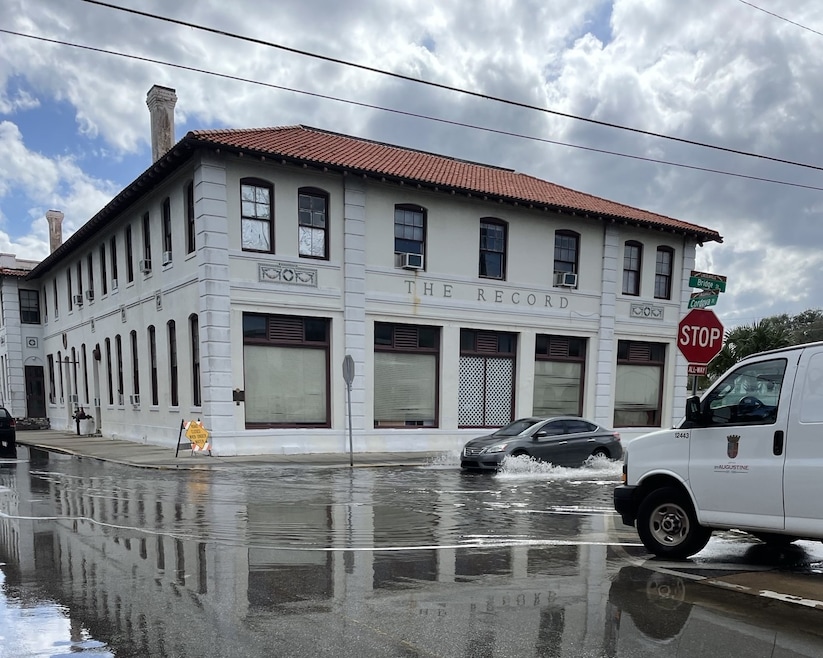As the highest of high tides more frequently cause flooding in areas across coastal Florida, homeowners need to be prepared to act because rising waters can damage their homes and property, experts say.
“We started pushing the warnings two years ago,” said Jessica Beach, St. Augustine, Florida’s chief resiliency officer. “Just to put it on people’s minds to be aware.”
King tides is a layman’s term for perigean spring tides, a phenomenon where high and low tides stretch beyond their usual limits. Occurring in both spring and fall, king tides are mostly noticeable in Florida in September and October.
While king tides have been happening as long as there has been a sun, a moon and oceans, rising seas are bringing them higher and more often into cities and communities where homes could be affected. The tides can contribute to coastal Florida’s widespread flooding issues, and they are offering experts a glimpse of the impact that more permanent sea level rise will have on the state.
“There will need to be some neighborhoods that get abandoned,” said Colin Polsky, associate vice president of the Broward County campuses of Florida Atlantic University. Polsky is also a founding member of the school’s Center for Environmental Studies.
High tides are getting higher
Tide stations across Florida have measured water levels more than 2 feet above normal during king tides, according to The Invading Sea, a publication by FAU. In October 2023, Miami Beach saw a rise of 2.75 feet.
The ocean has four tides every day, two high and two low. A typical year might include fewer than 10 king tides, and not all will cross into urban areas. “You can count [annual incidents] on two hands,” Polsky said.
Once the water is there, it will be there for roughly two hours, Polsky said. It will drain with the low tide but return six hours later with the arrival of the next high tide.
What’s happening is that more king tides are encroaching farther into cities. “We’re seeing an increase in the frequency of high tides breaching places they didn’t breach before,” Beach, the St. Augustine officer, said.
In St. Augustine, the tides can be high enough to reach King Street downtown, whether the water comes over the ground from the beach or surges through the storm drains and floods lower streets.
“It can affect residents being able to navigate to different places,” Beach said, adding that the city puts up signs on streets where flooding is predicted.
Driving through salt water can damage the underside of vehicles. The city recommends that people who have to drive through flooded roads drive slowly, but Beach said many drivers speed up to avoid getting stuck in low points.
“The wake [from speeding cars] is actually what creates the damage,” she said. “That wake can get into garages and houses.”
When this occurs, the primary concern is from saltwater corrosion, Polsky said. “That's definitely bad for your automobile when you drive through standing water," he said. "Similarly, when the water is in your lawn, the saltiness is going to torch your grass and your garden. If you get water in your house, whether it's saltwater or freshwater, it stinks."

Compound flooding
King tides are as predictable as Earth’s orbit, and cities such as St. Augustine have installed monitors to get an idea of how much water they will bring. Still, one of the biggest hazards with the tides is known as sunny-day flooding, when most people aren’t expecting to drive into a sudden river.
Current king tide levels don’t typically enter St. Augustine homes, Beach said, but they can be exacerbated by heavy winds and fall storms that create an event known as compound flooding.
Beach recalled a nor’easter that slammed her city during a king tide in 2020. “It’s like flooding everywhere,” she said.
But unlike other major storms, this wasn’t accompanied by any warning from the National Weather Service. “There’s not really an official event, but we experienced it locally. It heightens our desire to push information out.”
Tides and sea level rise are tough to fight. St. Augustine and other cities have installed tide check valves that work to reduce or prevent seawater from entering the storm drain system.
“Those work pretty well,” Beach said. “They’re not a 100% solution, but they help.”
Polsky called valve technology a “Band-Aid.” Mitigation strategies are available but limited, he said.
“There's some diversion of the water—you can build retention ponds and swales, and there are things you can do that will allow us to live with the water better,” Polsky said. “You can invest in a stronger pump at the sea gates … There's not a single technology or answer to it.”
'A delicate conversation'
As for determining which communities will have to undergo the drastic step of depopulating, “that’s a delicate conversation,” Polsky said.
The Southeast Florida Regional Climate Compact estimates roughly 10 to 17 inches of sea level rise by 2040, and it predicts that could lead to approximately 573 additional tidal events annually in South Florida alone.
Polsky said the size of the challenge is daunting, but people are stepping up to address it.
“Sometimes it's a real sobering experience being in this field, but it's also sometimes quite inspirational," he said. "The work that's gone on here in the last five to ten years is really quite amazing. It gives one a sense of optimism, even though we know the process of fewer neighborhoods is underway."
Beach said St. Augustine is working on an alert system for king tides that it hopes to debut this fall.
“We’re a very low city,” she said. “It’s a game of inches.”
